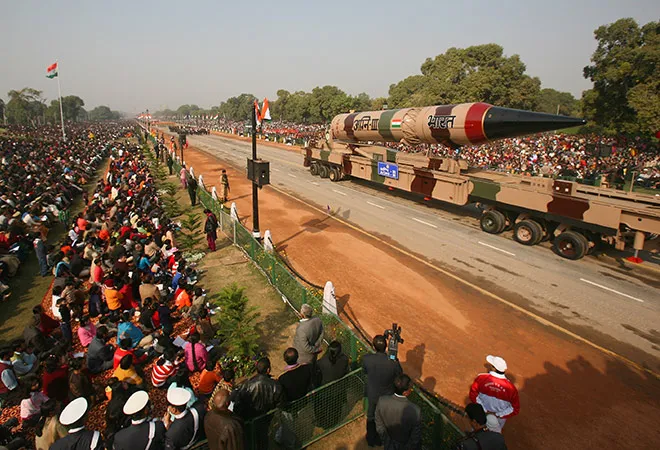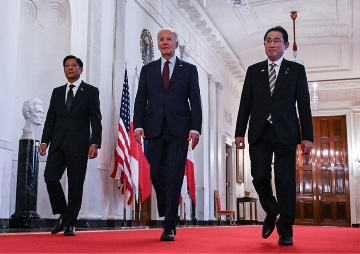
For the last seven decades, nuclear weapons have remained the cornerstone of international security. The nuclear balance of terror — the ability of nuclear weapon states to assure punitive retaliation against their adversaries — has maintained a “long peace” or “strategic stability” between nuclear-armed adversaries. This mutual vulnerability among nuclear weapon states is now under threat from the rapid technological progress made in the field of artificial intelligence (AI), surveillance capabilities, cyber domain, and hypersonic weapons in the last two decades or so. As these ‘disruptive technologies’ mature, which the World Economic Forum (WEF) calls the ‘fourth industrial revolution,’ the world is now at the cusp of a technological revolution which has the potential to undermine the most fundamental assumption behind nuclear deterrence: The capability of nuclear weapon states to impose unimaginable damage on their nuclear-armed adversaries.
The nuclear balance of terror — the ability of nuclear weapon states to assure punitive retaliation against their adversaries — has maintained a “long peace” or “strategic stability” between nuclear-armed adversaries.
India was a late entrant to the game of nuclear deterrence. Even when it was technologically one of the most advanced countries amongst the third world in atomic research in 1950s and 60s, it took Indian decision-makers almost five decades to fully embrace the logic of nuclear deterrence. In 1998, when New Delhi declared itself a nuclear weapon state, nuclear deterrence assured that India could neutralise the threat emanating from Chinese and Pakistani nuclear weapons. Since then, India has continuously strived towards creating a robust nuclear deterrent by increasing the technological sophistication of its nuclear delivery vehicles and also by augmenting their survivability. India’s pursuance of long-range ballistic missiles, sea-based nuclear vector, a limited ballistic missile defence programme, Multiple Re-entry Launch Vehicles (MIRV) and an elaborate command and control mechanism was an evolutionary response to its requirements of creating a robust deterrent posture against its nuclear adversaries. Both survivability and credibility of India’s nuclear deterrence hinged upon this technological evolution. In other words, these technologies favoured the status quo of nuclear deterrence.
Rapid transformation in ‘disruptive technologies’ is, however, going to change the nature of nuclear deterrence. Artificial intelligence, cyber weapons, hypersonic weapons and persistent surveillance, by themselves or in combination with one another, will threaten the survivability of nuclear arsenals, thereby eroding the confidence in a nuclear weapon state’s ability to retaliate meaningfully. First, it will be increasingly difficult to hide nuclear delivery platforms from the prying eyes of the adversary. Second, these technologies will be able to target the nuclear command, communication and critical infrastructure networks, disrupting an adversary’s nuclear decision-making chains. Lastly, advanced conventional precision strike weapons will provide pinpoint targeting of nuclear assets. If the undergoing technological revolution, therefore, provides incentives and expands options for carrying out splendid first strikes by advanced nuclear weapon states, it also creates pressure on less technologically endowed countries to put their nuclear arsenal at a hair-trigger operational status. As an emerging nuclear power which is still striving to attain a robust second-strike capability, India is set to lose the most as and when these technological innovations are employed in the nuclear battlefield.
If the undergoing technological revolution, therefore, provides incentives and expands options for carrying out splendid first strikes by advanced nuclear weapon states, it also creates pressure on less technologically endowed countries to put their nuclear arsenal at a hair-trigger operational status.
Artificial intelligence allows weapon systems to monitor the physical space and respond to myriad threats independent of human intervention. AI and AI-informed autonomous weapons have the potential to transform the battlefield significantly. Unlike the domain of human decision-making, AI allows very rapid assessment of information. Action-reaction loop is therefore considerably small. Second, the ability of independent action eliminates the element of human intervention. In a fully autonomous battlefield, crisis escalation will be difficult to contain. Both initiative and speed, two significant aspects of military strategy, will, therefore, rest with those who have mastered AI. AI will also allow for persistent surveillance of adversary’s nuclear assets. States will find it extremely difficult to hide their mobile land-based missile systems and SSBN’s, the mainstay of nuclear delivery platforms. Autonomous weapons could then be employed to hunt such nuclear platforms. For example, the Pentagon is currently working on ‘attack swarms’ of sea-based autonomous weapons, also known as the wolf-packs, to detect and destroy enemy SSBNs.
If AI threatens the survivability of nuclear arsenals, hypersonic weapons which travel five times the speed of sound can penetrate any layered missile defence systems. Even when detected during the launch phase, their target-trajectory is extremely difficult to read. When combined with precision munitions, their extraordinary speed, immense maneuverability, and enhanced lethality would ensure minimal reaction time for the targeted state. Nuclear weapon states facing adversaries with such capabilities would naturally shift the operational readiness of their nuclear arsenals to hair-trigger or launch-on-warning status. Lastly, offensive cyber operations would disable an adversary's early-warning, command and control, communications and critical infrastructure. Once disrupted, states will be vulnerable to preemptive nuclear first strike without recourse to any effective retaliation. If nuclear weapons had privileged the cult of the defensive for the last seven decades, these disruptive technologies incentivise offense. Nuclear decapitation, the worst fear of all nuclear weapon states, may soon become a reality. Conventional foundations of nuclear deterrence are therefore fundamentally threatened by the ongoing technological revolution.
If AI threatens the survivability of nuclear arsenals, hypersonic weapons which travel five times the speed of sound can penetrate any layered missile defence systems.
Even when it will some time for these technologies to become fully operational, an arms race is already underway. US, Russia, and China are currently leading the world in the development of AI, cyber weapons and hypersonics. The problem for India is two-fold. First, irrespective of specific threats to Indian nuclear deterrent from these countries, an arms race involving the US, Russia, and China in such ‘disruptive technologies’ will force India to develop similar systems but also invest in counter-capabilities. It is particularly worrisome because India is still in the process of creating a robust nuclear deterrent. It's ICBM force and sea-based nuclear force is still under development.
Moreover, India’s nuclear command and control infrastructure is relatively unproven, and there are concerns about the reliability of its nuclear decision-making infrastructure. If India's nuclear deterrent has yet to reach a stage of maturity compared to more established nuclear powers, India lags dangerously behind USA, Russia, and China when it comes to R&D on AI, cyber domain and hypersonic weapons. Even till date, Indian military does not have a unified cyber command. Indian decision-makers should be particularly worried about the advances in Chinese capabilities because unlike the US and Russia, India faces a direct nuclear threat from China. A successful Chinese breakthrough in such technologies will render India’s nuclear arsenal vulnerable to a Chinese first strike. Even in the conventional domain, these technologies will provide a significant advantage to India’s adversaries.
Military disadvantage notwithstanding, technological incapacity may also lead to India’s marginalisation in international diplomacy. New Delhi's decision to remain non-nuclear in the 1960s led to its exclusion from the nonproliferation treaty. For almost four decades, India was an outcast to the global nonproliferation regime. Having the necessary capability will provide India an ability to influence diplomatic efforts currently being pursued to manage the negative fallouts of these disruptive technologies. Indian decision-makers should read the writing on the wall and ensure that in the undergoing technological revolution, it does not fall by the wayside, the consequences of which will be felt much beyond the nuclear domain.
Indian Nuclear Policy (Oxford University Press, 2018).>
The views expressed above belong to the author(s). ORF research and analyses now available on Telegram! Click here to access our curated content — blogs, longforms and interviews.



 For the last seven decades, nuclear weapons have remained the cornerstone of international security. The nuclear balance of terror — the ability of nuclear weapon states to assure punitive retaliation against their adversaries — has maintained a “long peace” or “strategic stability” between nuclear-armed adversaries. This mutual vulnerability among nuclear weapon states is now under threat from the rapid technological progress made in the field of artificial intelligence (AI), surveillance capabilities, cyber domain, and hypersonic weapons in the last two decades or so. As these ‘disruptive technologies’ mature, which the World Economic Forum (WEF) calls the ‘fourth industrial revolution,’ the world is now at the cusp of a technological revolution which has the potential to undermine the most fundamental assumption behind nuclear deterrence: The capability of nuclear weapon states to impose unimaginable damage on their nuclear-armed adversaries.
For the last seven decades, nuclear weapons have remained the cornerstone of international security. The nuclear balance of terror — the ability of nuclear weapon states to assure punitive retaliation against their adversaries — has maintained a “long peace” or “strategic stability” between nuclear-armed adversaries. This mutual vulnerability among nuclear weapon states is now under threat from the rapid technological progress made in the field of artificial intelligence (AI), surveillance capabilities, cyber domain, and hypersonic weapons in the last two decades or so. As these ‘disruptive technologies’ mature, which the World Economic Forum (WEF) calls the ‘fourth industrial revolution,’ the world is now at the cusp of a technological revolution which has the potential to undermine the most fundamental assumption behind nuclear deterrence: The capability of nuclear weapon states to impose unimaginable damage on their nuclear-armed adversaries.
 PREV
PREV


